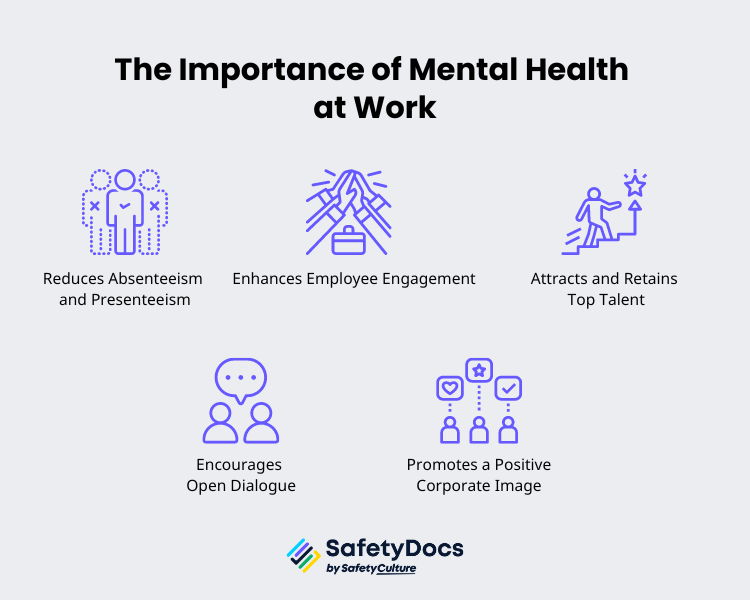Mental health issues rank as the third most significant health concern in Australia, following heart disease and cancer. Roughly 45% of Australians aged 16 to 85 are expected to face a mental illness during their lifetime. Additionally, one in five Australian adults experiences a mental illness every year. Notably, around 20-25% of patients who visit a general practitioner seek support or treatment for anxiety or depression.
Mental health at the workplace is not exempt from these statistics. Employees face additional sources of stress that can take a toll on their mental well-being, such as long schedules, office politics, and performance pressures. This blog post aims to provide an in-depth guide to promoting mental health at work, covering its importance, challenges, and strategies for fostering a mentally healthy workplace.
Psychosocial Hazards
When we talk about workplace mental health, we're referring to psychosocial hazards, which are defined as risks to an employee's mental, emotional, and social well-being. These can include but are not limited to:
- Stress due to workload demands
- Bullying and harassment in the workplace
- Isolation from colleagues
- Lack of job security
- Lack of role clarity
- Remote or isolated work
- Challenging physical conditions
- Acts of violence and aggression
These hazards can interact and magnify, leading to higher risks for employees. Some hazards may not pose significant risks alone but can escalate when combined with others. For example, high workloads paired with inadequate breaks can increase stress levels.
Impact of Mental Health at Work
The impact of these psychosocial hazards on an individual's mental health should not be taken lightly. Some impacts include:
Productivity
Mental health issues can lead to employees taking time off work. In Australia, 20% of employees have experienced the need to take time off work due to feelings of stress, anxiety, depression, or mental instability. Each year, workplace stress causes an average loss of 3.2 days per worker. This time off can lead to reduced productivity and increased costs for employers.
Furthermore, mental health problems can have a direct impact on employees' performance. High levels of anxiety or depression can lead to issues such as poor concentration, difficulty making decisions, reduced motivation, and increases in absenteeism. These issues may also reduce motivation levels at work and result in poor quality of work.
Financial Impact
Every year, Australian businesses suffer a loss of over $6.5 billion due to their failure to offer timely intervention and treatment for employees grappling with mental health issues. Untreated mental health conditions have a significant financial impact on companies. The expenses associated with workers' compensation claims for stress-related conditions in Australia are significantly high.
Medical Costs
When employees don't receive effective treatment for address mental health illnesses, it results in higher total medical costs for the employer. In 2014-15, the total direct healthcare cost of mental illness for all age groups in Australia was estimated to be AU$ 8.5 billion. This encompassed mental health expenditures in hospitals, out-of-hospital services, pharmaceuticals, and community services.
Employee Morale and Engagement
Struggling with a mental health condition can lead to feelings of isolation, reducing their participation in team activities and their overall involvement in the workplace. This decline in engagement can negatively impact team cohesion and the overall work atmosphere. In addition, employees battling mental health issues may find it difficult to find motivation, which can lead to lower job satisfaction and decreased loyalty to the organisation.
Importance of Mental Health at Work
Given the enormous impact of mental health on both employees and employers, it's essential to create a workplace that is conducive to good mental health. This is why prioritising the mental health of your workers can have a positive effect on your business.
Here are more reasons why it is crucial:
1. Reduces absenteeism and presenteeism
Mental health problems are one of the leading causes of absenteeism at work. Employees dealing with mental health issues may also experience presenteeism, where they are physically present at work but are not functioning at their full potential.
When employers prioritise and support workers' mental health, they can create a work environment that is conducive to productivity and helps workers stay at work. This reduces the amount of time taken off due to mental health issues, resulting in increased efficiency and reduced costs.
2. Enhances Employee Engagement
Employees who feel their mental health and well-being are valued by their employers are likely to be more engaged in their work. They tend to be more committed, putting in extra effort and showing a greater sense of loyalty towards their organisation.
3. Attracts and retains top talent
In 2022, some experts predicted that the "Great Resignation" trend would hit Australia, with the turnover rate potentially reaching 15% by the end of the year and continue in 2023. Companies that prioritise mental health are more attractive to job seekers, particularly millennials and Gen Z workers who value workplace wellness. These companies are also more likely to improve mental health and retain their employees, reducing the costs associated with high turnover rates.
4. Encourages open dialogue
When a worker's mental health is prioritised, it creates an environment where employees feel comfortable discussing their concerns and seeking help when needed. For instance, employers can set up an anonymous hotline for workers to report any mental health-related issues. This leads to early intervention, preventing minor issues from escalating into major problems.
5. Promotes a positive corporate image
Companies that take care of their employees' mental health are viewed more favourably by customers, investors, and the general public. By emphasising their commitment to supporting mental health well, employers can boost their corporate image and reputation.
Challenges in Promoting Mental Health at Work
Despite the many benefits of promoting mental health, there are some challenges that employers can face. These include:
- Lack of Transparency: Employers may worry about the potential ramifications of discussing mental health openly in the workplace, such as liability issues or fears that employees with mental health problems might be stigmatised. This could lead to a lack of transparency regarding mental health policies and initiatives at work.
- The stigma around mental health: Despite increasing awareness, there is still a significant stigma attached to mental health issues, making it difficult for employees to openly discuss their struggles and seek help.
- Stress and burnout: High levels of stress and burnout are common in many workplaces, contributing to poor mental health. Without effective strategies to manage stress, employees' mental health can deteriorate over time.
- Lack of understanding or awareness: Many employers and managers lack understanding about mental health issues and their impact on the workplace. This gap in knowledge can prevent them from effectively supporting their employees.
- Difficulty identifying mental health issues: It can be challenging for managers to identify employees who are struggling with mental health issues, particularly as these often manifest as changes in behaviour or performance.
- Limited resources: Not all companies have the resources to provide comprehensive mental health support, such as on-site counsellors or comprehensive health insurance that covers mental health services

Creating a Mentally Healthy Workplace
1. Strategies for Promoting Mental Health at Work
Fortunately, there are many strategies that organisations can use to promote better mental health, in the workplace. Here are some of them:
- Offer flexible working arrangements: Many organisations are now offering flexible working arrangements, such as remote work and part-time hours, to give employees more freedom and control over their schedules.
- Provide mental health training for managers: Managers need to be aware of mental health issues and trained in how to identify them. This enables them to provide better support for their team members.
- Involve leadership support: Leadership should believe in promoting good mental health at work. Building trust with your staff can encourage employees to share their experiences and seek help when needed.
- Conduct mental health first aid training: This training equips employees with the skills to assist someone who is developing a mental health problem or experiencing a mental health crisis.
- Create clear workplace guidelines for health and safety: Clear guidelines help employees understand what's expected of them and what support they can expect from their employer.
- Establish an employee assistance program: Employee assistance programs (EAP) can provide support to employees dealing with personal problems or work-related issues that may impact their job performance, health, and well-being.
2. Assessing Employee Well-being
In addition to implementing strategies for promoting mental health at work, employers should also assess the well-being of their employees on a regular basis. This can be done through:
- Mental health surveys: Explain the importance of regularly conducting anonymous surveys to assess employee mental health and identify areas for improvement.
- Scheduling check-ins: Highlight the value of having regular one-on-ones between employees and their managers to discuss any concerns they may have.
- Encouraging employee feedback: Make sure employees feel comfortable providing feedback about their overall experience in the workplace, from job satisfaction to mental health support.
3. Use a Risk Management Process
PCBUs (Persons Conducting a Business or Undertaking) have a responsibility to eliminate or reduce psychosocial risks to a reasonable extent. Achieving this involves adhering to a risk management process, encompassing the following steps:
1. Identifying Hazards
Psychosocial hazards can emerge from various sources, including work design, management practices, workplace surroundings, equipment, and interactions. This first step will help you to identify and document the potential sources of psychosocial risk, helping you understand and develop effective control measures.
2. Assessing Risks
Assessing risks is crucial for determining the level of danger and devising appropriate control measures. Consider the affected workers and the duration, frequency, and severity of their exposure to psychosocial hazards:
- What is the duration of workers' exposure to hazards or risks?
- What is the frequency of workers being exposed to hazards or risks?
- What is the extent of the hazards and the level of exposure experienced by workers?
For example, when evaluating high workloads, it is important to determine which workers are affected, the duration and frequency of these workloads, as well as the degree to which they exceed normal levels.
3. Controlling Risks
Eliminating risks is the primary goal if reasonably practicable. If elimination isn't feasible, then reducing risks to an acceptable level becomes the objective.
4. Monitoring and Reviewing Control Measures
The final step involves consistently monitoring the effectiveness of implemented control measures. Should a control measure prove ineffective, it must be modified or replaced.
Adhering to the risk management process ensures that psychosocial risks are diligently identified, assessed, controlled, and continuously reviewed. By prioritising these steps, PCBUs can create safer and healthier work environments that contribute to the well-being of their workforce while aligning with legal obligations and ethical responsibilities.

SafetyDocs: Your Tool for Completing Your Workplace Safety Strategies
Creating a mentally healthy workplace is not complete without a comprehensive safety system.SafetyDocs by SafetyCulture is your partner in developing a well-rounded safety system for mentally healthy workplaces. We provide organisations and businesses with a wide range of templates, checklists, and documents to help guide their workplace safety strategies. From conducting regular workplace assessments to creating hazard registers, SafetyDocs can cover all your safety needs and ensure that your workplace is compliant with relevant regulations.
Here are the documents in relation to mental health at work to start with:
- Psychosocial Hazards Management Plan
- Psychosocial Hazards Policy
- Sexual Harassment Policy
- Bullying Policy
With SafetyDocs, organisations can easily create a comprehensive safety system and ensure their employees' health and safety. Start building your safety system today and create a mentally healthy work environment for your team. Contact us for more information.
Our team of experts is dedicated to providing accurate and informative content. Craig Cruickshank, our senior HSEQ advisor at SafetyDocs by SafetyCulture has reviewed this blog post to ensure the highest level of quality.
Learn more about Craig's work on LinkedIn for more industry insights.
Available for instant download and supplied in fully editable MS Word format for use in your business.
Please note that the above information is provided as a comment only and should not be relied on as professional, legal or financial advice.
Share This Article

